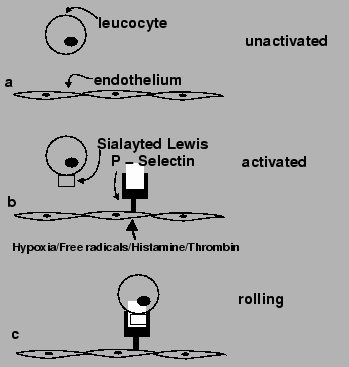



Next: Rolling
Up: Outline of endothelial function
Previous: Mac-1, CD11b/CD18
Index
The accumulation of leucocytes in damaged tissues depends upon the interaction
of leucocytes with the endothelium in the damaged tissue, see
figure 2. There is a continuum between the stages of
rolling, adherence and transmigration.
Most of the manifestations of inflammation in a tissue, (leucocyte
accumulation, filtration of fluid and protein) only occur in the post
capillary venule.
Figure 7:
Schematic representation of the
molecular mechanism of rolling in leucocytes in post capillary venules. a)
shows the unactivated state with no expression of selectins on the leucocyte
of the endothelium. b) shows the activated state with P-selectin expressed on
the endothelium, P-selectin is released from the Weibel-Palade body in
endothelial cells. Expression is induced by hypoxia, free radicals, histamine
and thrombin. In c) the leucocyte has grabbed on to the endothelium with
binding of sialyated Lewis to P-Selectin. The binding is not very tight as the
leucocyte may pop off again with the appearance of rolling on microscopy.
 |
Subsections




Next: Rolling
Up: Outline of endothelial function
Previous: Mac-1, CD11b/CD18
Index
Adrian P. Ireland